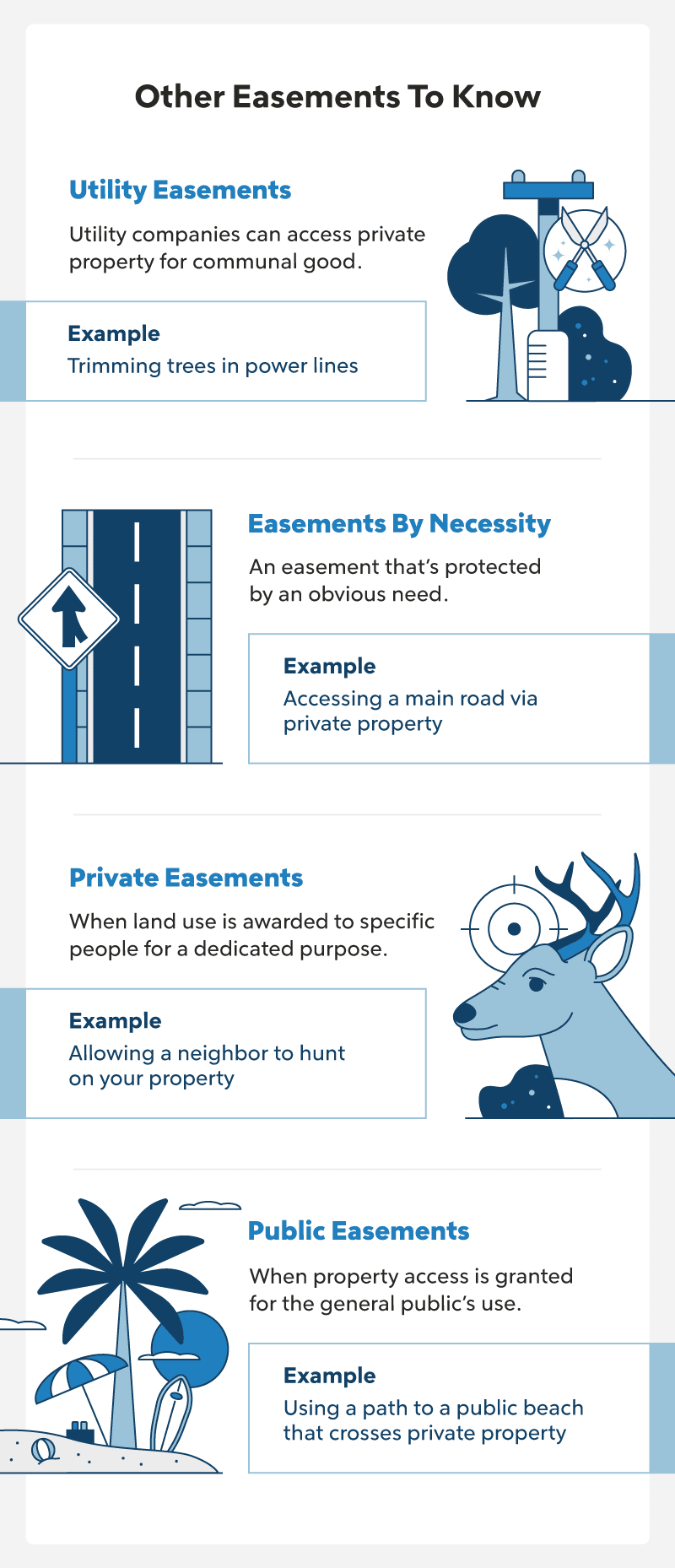Occasionally when buying a house, the home buyer may discover that the property has an easement. A property easement is a legal situation in which the title to a specific piece of land remains with the landowner, but another individual or entity is given the right to use that land for a distinct purpose.
Land easements don’t affect your ownership, but they can affect some of your property rights. Below, we’ll cover everything you need to know about easements and how to tell if your property is affected.
Table of Contents
See What You Qualify For
Buy A Home
Discover mortgage options that fit your unique financial needs.

Refinance
Refinance your mortgage to have more money for what matters.
Tap Into Equity
Use your home’s equity and unlock cash to achieve your goals.
Easement Definition And Examples
As stated above, an easement is a type of property right that grants a person or entity permission to use another person’s land for a specific purpose. For example, a utility company may have an easement that allows them access to an electrical pole on your property. You could also have an easement on part of your property if it blocks access to a main road.
In the case of an easement, the dominant estate, or dominant tenement, is the party that benefits from the easement and has usage rights. The servient estate, or servient tenement, holds the burden of easement and allows the other party to use their property while they maintain possession of the property title.
How Do Easements Work?
Easements are often upheld through ownership transfers and may be legally documented or protected through informal use. Ultimately, the easement rights depend on the type of easement applied to your property.
Types Of Easements
There are several types of easements, each with its own set of specific circumstances. If there is an easement on your home or you have one on another property, it’s important to know which type of easement it is so you know your rights.
Categories Of Easements
While there are three main types of easements, you should also know that each can be a public or private easement, and an affirmative or negative one.
A private easement is one that grants land use rights to certain people, whereas a public easement grants those rights to the general public. An affirmative easement allows someone to do something on the property, while a negative easement forbids it.
During your house hunt, it’s important to carefully review property disclosures and check for easements before making an offer on a house. This way, you’ll understand all your property rights as a new homeowner.

Easement Appurtenant
An easement appurtenant is a property easement that is not limited to a period of time or property owner. Instead, it’s tied to the property itself. An easement appurtenant is often referred to as “running with the land,” as it remains in place even when the owners change. It’s an easement that benefits the property.
Easement Appurtenant Example
If you sell your property with access to a private beach shared by two neighbors, the new owners must allow their neighbors access to the beach via their property. The easement isn’t void or affected by new ownership since it’s tied to the property itself.
Easement In Gross
An easement in gross is tied to a specific person or entity, not the property itself.
An easement in gross is typically irrevocable and can’t be voided until the easement holder passes away or the home is sold. If the home is sold, the seller may transfer the easement to the new owner, or the new owner can choose to deny the easement. However, if the easement is from a public entity like a utility company, you could be taken to court if you deny the easement.
While the easement can be transferred to new homeowners of the servient property, the easement holder can’t transfer their rights to use it to another person or business. If a new person or public utility company wishes to use the servient property, they must file a new easement.
Easement In Gross Example
Utility companies often hold easements in gross to build and maintain power lines on or near a person’s private property. Typically, the companies will have a utility easement to access the property and lines.
A more personal example of an easement in gross could be one that allows a friend to use a shared trail that crosses your property.
Easement By Prescription
Easement by prescription, also referred to as a prescriptive easement, is created when a person continuously uses another’s land for a long period of time as if they had an easement. This is different from adverse possession, which grants legal title rights to an encroacher. To get an easement by prescription, the following criteria must be met:
- Continuous use for a specific period of time: The set amount of time varies by state law. For example, in Michigan, someone must have been using the land for at least 15 years before they can get the easement. California law requires at least 5 years of use.
- Open and notorious use: The use of the property must be obvious and observable – not done in secret.
- Hostile use: The property must be used without the owner’s permission. Despite the term, this isn’t always malicious. The person could be doing this unknowingly.
- Exclusive use: This isn’t required in all states and the definition of exclusive use may differ among laws. Exclusive use could require that the use of the property can’t occur while the true owner of the property uses it, or it could require that the property is used in a different way than what is intended for the general public.
Easement By Prescription Example
Let’s say you live on a waterfront property in California and a neighbor has used your dock for sunbathing and occasionally docking their boat. They never asked your permission, but they have been doing so for the last 5 years. They could get an easement of prescription to continue to use your property for such activities in the future.
Another example is if a neighbor unknowingly built their fence 3 feet over their boundary line onto your property and it was only discovered 15 years later. They may be granted a prescriptive easement since they meet all of the criteria above.

Other Types Of Easements To Know
When learning about easements, it may be helpful to be aware of the following types:
- Utility easements: As touched upon earlier, utility companies are given the right to access power lines and other infrastructure on a private property. This type of easement is created by state or local law.
- Easements by necessity: This type of easement is created when another individual has a need to access your property, such as if a neighbor can only access a main road by crossing your property. Property owners don’t have the right to stop or remove easements by necessity.
- Private easements: Private easements can be created by the property owner and then given or sold to another individual. Private easements are listed on a property’s title and can affect future property owners.
- Public easements: Property access can be granted for the general public’s use via a public easement. For example, a public easement might allow beachgoers to access a public beach by walking on a pathway on your property.
Find A Mortgage Today and Lock In Your Rate!
Get matched with a lender that will work for your financial situation.
How Long Do Easements Last?
The length of an easement depends on the type of easement applied to a property. Generally, easements last until they’re challenged, but some easement types can be denied when the property transfers ownership.
Appurtenant easements are tied to the property and will last as long as they aren’t challenged, even if the property is transferred to a new owner.
Easements in gross last until a property is transferred to a new owner, and even then, the easement may transfer depending on its purpose. If the easement is for a utility company to access the property, that easement will remain in place, or the new owner may be vulnerable to lawsuits.
Easements by prescription, like allowing children to cross your yard to go to school for years, will remain in place until an alternative that voids the initial need is made available. If this easement isn’t formally attached to the deed, the dominant estate can challenge the property owners should they disrupt the easement in court to get it formally filed with the deed.
How To Create An Easement
There are a few different ways to go about creating a land easement. The method you use depends on the type of property you have, the reason for the easement and whether you can reach the easement amicably with the other party or property. If an easement needs to be created, it will happen in one of the following ways.
- Express easement: This is the most common way to create an easement. It’s a written agreement included in a deed or will and signed by both parties.
- Implied easement: This is an informal agreement that isn’t legally recorded but upheld by an obvious need. For example, you sell part of your land but still need access to the sold property to reach the main road.
- Easement by necessity: If an implied agreement can’t be reached but there’s an obvious need for an easement, one can also seek an easement by necessity to legally grant property access. You’ll want to consult a real estate attorney to bring this matter to the courts.
In the case that you need written legal documentation of an easement, you’ll need to consult an attorney to draft the proper documents and include them in your deed or will. Additional steps like a property survey may also be required depending on the easement agreement between the dominant and subservient estates.
How To Find An Easement On A Property
Before you purchase a home, you’ll read through disclosure documents that include anything that can negatively affect the value or enjoyment of the home. If the seller knows of any easements on the property, they are legally required to list them in the disclosures.
Otherwise, you can also consult these offices and professional services to identify property easements:
- Local assessor’s office
- County clerk’s office
- Utility companies
- Property search
- Title search
What To Do If A Home You’re Buying Has An Easement
If the home has an easement, don’t fret just yet. While it could be an annoyance, it could very well benefit you as the homeowner. Or it could be an entirely neutral experience.
First, find out what type of easement your property has. Appurtenant easements are tied to the property, so you’ll have to abide by it. However, gross easements can be challenged when you take ownership of the property.
Abiding By An Easement
An easement is legally binding and must be followed, or else you may be vulnerable to a lawsuit.
For example, if the only way your neighbor can access the public beach is by crossing your property and you prevent them from doing so, they could sue you. However, if the easement states that they can only use your driveway to get to the beach and they start walking all over your property, you could take them to court.
To properly abide by an easement and ensure the other party is doing the same, make sure you understand each party’s rights. If you have questions or seek to understand more, consult a real estate lawyer.
Removing An Easement
An easement can be challenged, but it’s an extensive process that may involve going to court. The easiest way to remove it is if the easement holder agrees to terminate the easement or if it has an expiration date. Otherwise, you may end up in court in a complex dispute that often carries a lot of emotion if it involves neighbors. We recommend consulting a real estate lawyer to learn more about challenging an easement.
Should You Buy Property With An Easement?
There’s no right or wrong answer – buying a property with an easement ultimately depends on the easement agreement and your personal preference. If an easement is tied to the land until challenged, you have to decide if you can live with the specific details of that easement.
If the easement is in gross and not connected to a recurring or protected need, like a utility company accessing its assets, you may not have to worry about the agreement once you take ownership.
In any case, it’s best to talk to a real estate lawyer to determine how an easement affects your property rights before you agree to purchase a property, especially since an easement can impact your negotiating power and the home’s ability to be resold.
Property Easement FAQs
Easements and property disputes can be complicated, and we’re here to help. Check out these additional things to know if your property has an easement.
Will an easement affect my ownership?
An easement doesn’t have any effect on your ownership, nor does it grant anyone else a right to claim ownership of your property. However, it does give some parties access to use your property for a specific purpose as outlined in the easement.
Will an easement impact my property value?
Easements don’t have a direct impact on your property value and won’t increase or decrease it. However, an easement may impact your ability to sell the property if the easement is appurtenant (tied to the property) and has strict rules that may discourage potential buyers or result in lower offers. Additionally, items related to the easement may impact your property value, like newly installed utility equipment or a walking path that damages your landscaping.
How can I learn more about easements?
Easement rules and regulations can vary by location, so the best way to learn about your specific laws is through your local county clerk or real estate attorney.
The Bottom Line
An easement allows a person or entity to access another person’s property for a particular use. There are several types of easements, and each works slightly differently. Understanding easements is just one part of knowing your rights and responsibilities as a homeowner. Easements can potentially affect the property value, so it’s important to do your research before putting any money down.
Find A Mortgage Today and Lock In Your Rate!
Get matched with a lender that will work for your financial situation.

Victoria Araj
Victoria Araj is a Staff Writer for Rocket Companies who has held roles in mortgage banking, public relations and more in her 15-plus years of experience. She has a bachelor’s degree in journalism with an emphasis in political science from Michigan State University, and a master’s degree in public administration from the University of Michigan.












